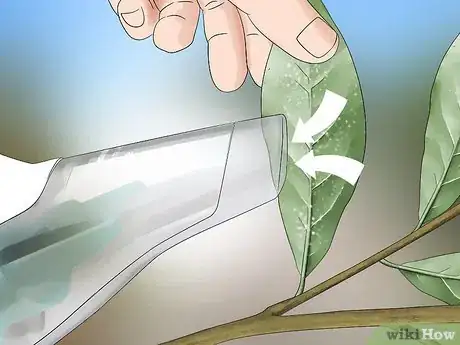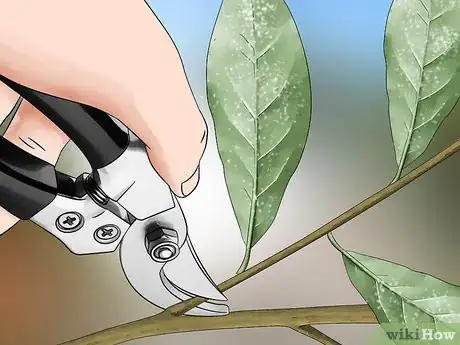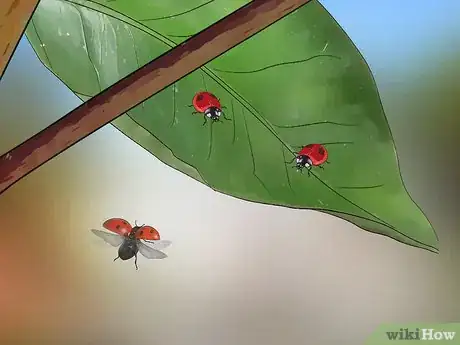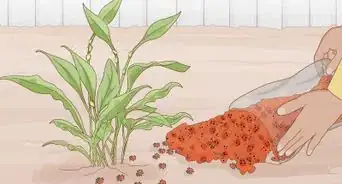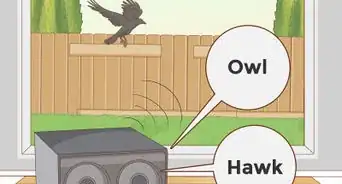This article was co-authored by Lauren Kurtz. Lauren Kurtz is a Naturalist and Horticultural Specialist. Lauren has worked for Aurora, Colorado managing the Water-Wise Garden at Aurora Municipal Center for the Water Conservation Department. She earned a BA in Environmental and Sustainability Studies from Western Michigan University in 2014.
There are 10 references cited in this article, which can be found at the bottom of the page.
wikiHow marks an article as reader-approved once it receives enough positive feedback. This article received 16 testimonials and 87% of readers who voted found it helpful, earning it our reader-approved status.
This article has been viewed 570,840 times.
There are over 1,000 types of whiteflies, insects that look like small white moths or aphids. They group and breed in large numbers on the undersides of leaves. The nymphs and adults damage plants directly by sucking the sap and by transmitting disease. Once an infestation has taken root, it is difficult to remove. You may need to apply multiple treatments over a period of weeks, and you may even need to trim back your plants.
Steps
Using Natural Solutions
-
1Vacuum the flies. Use a small hand vacuum, or hold the furniture-cleaning nozzle of a standard vacuum cleaner. Walk around your infested plants and suck the pests from the undersides of the leaves and foliage. This method is quick and straightforward, and it can remove whiteflies from all stages of the development cycle – from larvae to mature, plant-munching adults.[1] Vacuuming is most effective as soon as you notice an infestation.
- When the vacuum bag is full of whiteflies, trade it out. Seal the vacuum bag inside an airtight plastic bag, then put it into the freezer for at least 24 hours to kill off the insects. Once all of the flies are dead, you can empty the bag into the trash.
-
2Remove the severely diseased leaves and branches. Use garden clippers to trim away as much as you can without killing the plant. You can also pluck infested leaves by hand. Look for white eggs and wingless "crawlers" on the underside of the leaves. Extremely infested leaves may be coated with a sticky or waxy fluid—honeydew—that is produced when the feeding nymphs ingest plant juices.[2] Leaves may also appear pale and wilted.
- Only trim as much as is healthy for the plant. If a particularly delicate plant is infested, you should cut away only the most infected leaves. If the plant is hardy, consider paring all the way down to the stem in order to stop the infestation in its tracks.[3]
- Make sure to properly dispose of the diseased leaves. Burn them or seal them into an airtight bag. If you don't handle the leaves carefully, the whitefly infestation may spread again.[4]
Advertisement -
3Prepare for repeated applications. The whitefly matures in 4 stages: from eggs, to nymphs, to pupa, to the adult fly.[5] Each method typically only targets certain stages in the fly life cycle. Thus, if a method targets the adult fly, you will need to keep applying that treatment until all of the existing eggs have matured into adults. You will need to be quick and diligent in your treatments to make sure that the newly-formed adults do not lay new eggs.[6]
- The nymph and adult flies are the only stages that cause physical damage to the host plant. Younger whiteflies will, however, mature into more damaging forms if left unchecked.
- For the best application timeframe, check the lifespan and stages of your particularly whitefly. Various species—including the Silverleaf, Fig, Greenhouse, and Bandedwing whitefly—each have a different lifespan.
-
4Wash your plants with a soap solution. Put one good squirt of dish soap into 1 gallon (3.8 L) of water and mix well. Pay special attention to the undersides of the leaves, where most of the whiteflies live. Be aware that this method only kills the adult insect. Wash every 3 or 4 days to eliminate the new whiteflies as they emerge from pupa. Depending on the type of whitefly, you may need to continue this treatment for several weeks until the infestation is gone.
- If you use a highly-concentrated soapy solution, try applying it at the end of the day to avoid burning the foliage.
-
5Introduce a natural predator. Various other species of insect love to feed upon the whitefly, and you might be able to rein in the infestation by bringing the right predator into the ecosystem. This predator will depend on the type of whitefly. Consider green lacewings, lady beetles, ladybugs, minute pirate bugs, big-eyed bugs, wasps, and damsel bugs.
- Be careful when intentionally introducing any new insect species to your garden. The predators may take care of your whitefly infestation – but you may soon find yourself contending with far too many of the new bug! Research before you act.
Using Traps
-
1Use a sticky yellow pad. You can buy these traps in garden stores, or you can craft them at home. To make your own: coat a sturdy yellow surface (cardboard or wood) with a slow-drying adhesive substance. Glue, honey, motor oil, or petroleum jelly are good choices. Whiteflies are said to be attracted to the color yellow. When they flit to the yellow trap, they land and cannot free themselves from the glue.
- If you make your own trap, you may need to reapply the adhesive as it dries out. Glue, for instance, may dry within a matter of minutes or hours. Motor oil or petroleum jelly may be less immediately effective, but might stay sticky for longer.
- Make sure to remove the traps if you use a spray or a wash, or if you introduce natural predators.
-
2Place the traps close to the leaves. Whiteflies tend to group on the undersides of plant leaves, and your trap will be more likely to catch the insects if it is near their natural habitat.
-
3Know when to remove the traps. Take down the traps once the whitefly population is mostly dead, and you only find a few flies caught each day. The traps also have the potential to kill whitefly predators. Thus, they may not be well-suited to a low-level infestation unless these predators fail to keep the whiteflies in control. If the whitefly population bounces back and returns, then you can feel justified in resetting the traps.[7]
Repelling the Whitefly
-
1Repel whiteflies with companion plants. French and Mexican marigolds tend to repel whiteflies, as do nasturtiums. Put these companion plants into your garden to keep the pests from returning! Be aware that this is a preventative measure, and not a great solution for existing infestations.[8]
- Pot marigolds and calendulas are not effective repellents. Make sure to use the right variety! If you aren't sure, visit a nursery and specifically ask about companion plants that repel whiteflies.
-
2Spray your plants with a soap and water mixture. In a 32-ounce spray bottle, mix rubbing alcohol with water at a 2:5 ration. Then, add a tablespoon of liquid dish soap. Use the spray bottle to coat the leaves of plants that are at risk for whitefly infestations. If you don't overdo it, the spray shouldn't harm most plants – and it might keep the flies from putting down larvae.
- Consider spraying a small part of the plant and leaving it for a day or two to check if it has any negative impact on the plant before spraying the whole plant.
- Consider using a natural oil spray, such as Neem oil.
-
3Spray earthworm castings at the base of the plant. Earthworm castings, when added to the fertilizer bed of whitefly-infested plants, have been found to repel the flies within a matter of weeks or months.[9] As an added bonus, these castings are a rich natural fertilizer, and they can greatly stimulate plant growth. Ask for earthworm castings at a local garden store.
-
4Cover the ground in a reflective material. Spread a layer of aluminum foil or reflective plastic mulch on the ground around susceptible plants. This may make it much harder for adult whiteflies to locate host plants, which in turn can bring make them less likely to successfully lay eggs.[10]
- This step will require special water considerations. Plants surrounded by plastic mulch will need a drip irrigation system.
- Do not use mulch in hot weather. Too much mulch may overheat the plants.
Using Chemicals
-
1Understand the risks and the benefits of using insecticides. On one hand, a commercial pesticide is sometimes an effective way to quickly kill off the pests. The whitefly, however, is notoriously resistant to chemical products. Furthermore, these chemicals are often toxic to other organisms in the immediate ecosystem – including the plants and benign insects in your garden, pets and local wildlife, and even your family. Try to keep pesticides as a last resort.
-
2Be aware that whiteflies easily build up a resistance to pesticides. Indeed, the eggs and pupae are able to resist most common insecticides. If you do use chemicals, be sure to switch them out in several-day rotations to keep your fly population from adapting. Even so, there is a strong chance that the whiteflies will adapt. You may unwittingly create a strain of pesky super-flies!
Expert Q&A
-
QuestionHow do I get rid of mole crickets?
 Lauren KurtzLauren Kurtz is a Naturalist and Horticultural Specialist. Lauren has worked for Aurora, Colorado managing the Water-Wise Garden at Aurora Municipal Center for the Water Conservation Department. She earned a BA in Environmental and Sustainability Studies from Western Michigan University in 2014.
Lauren KurtzLauren Kurtz is a Naturalist and Horticultural Specialist. Lauren has worked for Aurora, Colorado managing the Water-Wise Garden at Aurora Municipal Center for the Water Conservation Department. She earned a BA in Environmental and Sustainability Studies from Western Michigan University in 2014.
Professional Gardener Using a commercially available pesticide is the recommended treatment of a mole cricket infestation. Test the suspected area for mole crickets by wetting the area with a soapy water solution. If you see mole crickets come to the surface you have a problem. Treat the confirmed area with a pesticide such as Imidacloprid.
Using a commercially available pesticide is the recommended treatment of a mole cricket infestation. Test the suspected area for mole crickets by wetting the area with a soapy water solution. If you see mole crickets come to the surface you have a problem. Treat the confirmed area with a pesticide such as Imidacloprid. -
QuestionOur whiteflies seem to resist Neem Oil, soap, shooting them with water, and everything else we have tried. Any other suggestions?
 NinoxTop AnswererNeedle manure could be a good natural insecticide. If it doesn't work, you should try chemical ones.
NinoxTop AnswererNeedle manure could be a good natural insecticide. If it doesn't work, you should try chemical ones. -
QuestionAre whiteflies attracted to light?
 NinoxTop AnswererYes, whiteflies are attracted to light. Light traps can be very useful to get rid of the whitefly.
NinoxTop AnswererYes, whiteflies are attracted to light. Light traps can be very useful to get rid of the whitefly.
Warnings
- Repeated application is often recommended for maintenance.⧼thumbs_response⧽
- Insecticides can be effective but can also be harmful when ingested. Much of the insecticides used for whitefly control have been linked to the death and severe decrease in numbers of bees, which are essential for pollination of flowering plants.⧼thumbs_response⧽
References
- ↑ http://www.getridofthings.com/pests/flies/get-rid-of-whiteflies/
- ↑ http://www.almanac.com/content/whiteflies
- ↑ http://ucanr.edu/sites/VCMG/Controlling_Whiteflies_in_Your_Garden/
- ↑ http://www.bayeradvanced.com/articles/whitefly-solutions
- ↑ http://www.planetnatural.com/pest-problem-solver/houseplant-pests/whitefly-control/
- ↑ http://www.ipm.ucdavis.edu/PMG/PESTNOTES/pn7401.html
- ↑ http://www.motherearthnews.com/organic-gardening/how-to-kill-whiteflies-zw0z1304zkin.aspx#axzz3EHSIiR8T
- ↑ http://www.getridofthings.com/pests/flies/get-rid-of-whiteflies/
- ↑ https://www.google.com/patents/US6475503?dq=worm+castings#v=onepage&q=worm%20castings&f=false
About This Article
If you want to get rid of the whitefly naturally, cut off the most infected parts of the plants. Then, vacuum up as many of the remaining flies as possible. To target the rest of the flies, mix a squirt of dish soap with 1 gallon of water and spray it onto the entire plant. Reapply the soapy water every 3 to 4 days to kill the insects as they reach adulthood. For advice from our Horticultural reviewer on making a whitefly trap and safely using insecticides, keep reading!
